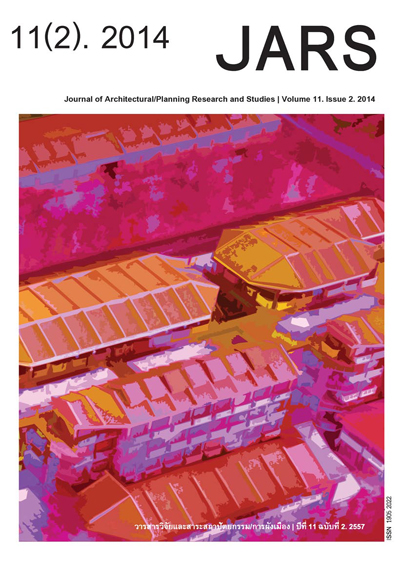Physical Characteristics and Ventilation Pattern in Uthai Thani city
Main Article Content
Abstract
The capability of urban ventilation is a major element of Urban Heat Island (UHI) intensity. The UHI intensity has an impact on human thermal comfort and varies in the each city. The well planned and designed cities with a consideration in urban ventilation get low heat accumulation. Thus, this study aims to identify physical characteristics and ventilation patterns of Uthai Thani municipality. The results show that Uthai Thani areas generally are residential and agricultural land uses, vegetation land cover and open space geometry. The impact of these physical characteristics on temperature between in the city and the suburb is not significant difference. The ventilation of the city has blown from southwest, northeast and south to north. Although, the influence of physical characteristics of Uthai Thani city on UHI intensity is low, it still need to take a consideration in land cover, land use, and ratio of building height and street width cooperating with the ventilation for the future urban expansion by (1) preserving vegetation and water land cover, (2) keeping agricultural land use in east and south of the city and allowing urban expansion in north areas, (3) considering the designation of building height, building gap and building width including the transportation routes parallel with the wind direction (north-south) in order to enhance fine urban ventilation.
Downloads
Article Details

This work is licensed under a Creative Commons Attribution-NonCommercial-NoDerivatives 4.0 International License.
All material is licensed under the terms of the Creative Commons Attribution 4.0 International (CC-BY-NC-ND 4.0) License, unless otherwise stated. As such, authors are free to share, copy, and redistribute the material in any medium or format. The authors must give appropriate credit, provide a link to the license, and indicate if changes were made. The authors may do so in any reasonable manner, but not in any way that suggests the licensor endorses you or your use. The authors may not use the material for commercial purposes. If the authors remix, transform, or build upon the material, they may not distribute the modified material, unless permission is obtained from JARS. Final, accepted versions of the paper may be posted on third party repositories, provided appropriate acknowledgement to the original source is clearly noted.
References
Arnfield, A. J. (2003). Two decades of urban climate research: A review of turbulence, exchanges of energy and water, and the urban heat island. International Journal of Climatology, 23, 1-26.
Blakely, E. J. (2007). Urban planning for climate change. Cambridge, MA: Lincoln Institute of Land Policy.
Chapman, L., Thornes, J. E. & Bradley, A. V. (2002). Sky-view factor approximation using GPS receivers. International Journal of Climatology, 22, 615-621.
Chulalongkorn University. (2011). รายงานแห่งชาติฉบับที่ 2: การศึกษาผลกระทบของการเปลี่ยนแปลงสภาพภูมิอากาศและความแปรปรวนของสภาพภูมิอากาศในอนาคตและการปรับตัวของภาคส่วนที่สำคัญ [The second national report: The study of an impact on climate change and variation in the future and an adaptation of the significant sectors]. Bangkok: Chulalongkorn University.
Collier, C. G. (2006). The impact of urban areas on weather. Quarterly Journal of the Royal Meteorological Society. 132, 1-25.
Emmanuel, M. R. (2005). An urban approach to climate sensitive design: Strategies for the tropics. London: Spon press.
Ferreira, D. G., & Assis, S. E. (2012). Urban ventilation study in the city of Belo Horizonte, Brazil. Retrieved October 20, 2012, from http://www.geo.uni.lodz.pl/~icuc5/text/P_8_13.pdf.
Givoni, B. (1998). Climate considerations in building and urban design. New York: Van Nostrand Reinhold.
Grimmond, C. S. B., Potter, S. K., Zutter, H. N. & Souch, C. (2001). Rapid methods to estimate sky-view factors applied to urban areas. International Journal of Climatology, 21, 903-913.
Katzschner, L. (1997). Urban climate studies as tools for urban planning and architecture. Proceedings of the IV Encontro Nacional de Conforto no Ambiente Construdo, Salvador, 49-57.
Komchadluek. (2013). สมิธชี้ไทยสังเวยคลื่นความร้อนแล้ว 15 ศพ. [Samit disclosed hot wave kill 15 Thai people]. Retrieved August 12, 2010, from http://www.komchadluek.net
Oke, T. R. (1981). Canyon geometry and the nocturnal urban heat-island - Comparison of scale model and field observations. Journal of Climatology, 1, 237.
Oke, T. R. (1982). The energetic basis of the urban heat-island. Quarterly Journal of the Royal Meteorological Society, 108, 1-24.
Oke, T. R. (1987). Boundary Layer Climates. Cambridge: Routledge.
Oke, T. R., Johnson, G. T., Steyn, D. G. & Watson, I. D. (1991). Simulation of surface urban heat islands under ideal conditions at night: Diagnosis of causation. Boundary-Layer Meteorology, 56, 339-358.
Oke, T. R. (2002). Urban heat island: An overview of the research and its implications. Urban Heat Island Summit. Metro Hall Council Chamber,Toronto, May 1-3, 2002.
Roth, M. (2000). Review of atmospheric turbulence over cities. Quarterly Journal of the Royal Meteorological Society, 126, 941-990.
Shashua-Bar, L., & Hoffman, M. E. (2003). Geometry and orientation aspects in passive cooling of canyon streets with trees. Energy and Buildings, 35, 61-68.
Srivanit, M., Hokao, K. & Iamtrakul, P. (2014). การจำแนกเขตภูมิอากาศความร้อนเพื่อสนับสนุนการวางแผนและจัดการสิ่งแวดล้อมเมืองในพื้นที่กรุงเทพมหานคร [Classifying thermal climate zones to support urban environmental planning and management in the Bangkok metropolitan area]. Journal of Architectural/Planning Research and Studies, 11(1), 73-92.
Svensson, M. K., & Eliasson, I. (2002). Diurnal air temperatures in built-up areas in relation to urban planning. Landscape and Urban Planning, 61, 37-54.
Tantasavasdi, C., Jareemit, D., Suwanchaiskul, A., & Naklada, T. (2007). Evaluation and design of natural ventilation for houses in Thailand. Journal of Architectural/Planning Research and Studies, 5(1), 85-98.
The Government Gazette. (2004). กฎกระทรวงให้ใช้บังคับผังเมืองรวมเมืองอุทัยธานี พ.ศ. 2547. [Ministerial Regulation on City Plan of Uthai Thani municipality, Uthai Thani Province B.E. 2547]. Department of Public Work and Town & Country Planning, Ministry of Interior.
Uthai Thani Municipality. (2012). ข้อมูลพื้นฐานของเทศบาลเมืองอุทัยธานี [Basic data of Uthai Thani municipality]. Retrieved October 25, 2013, from http://www.uthaicity.go.th/index.php/info-uthaicity.


